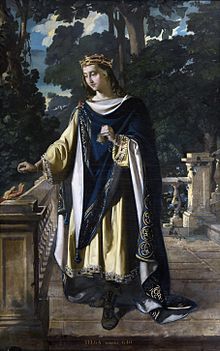Tulga
- Machine translation, like DeepL or Google Translate, is a useful starting point for translations, but translators must revise errors as necessary and confirm that the translation is accurate, rather than simply copy-pasting machine-translated text into the English Wikipedia.
- Consider adding a topic to this template: there are already 5,022 articles in the main category, and specifying
|topic=will aid in categorization. - Do not translate text that appears unreliable or low-quality. If possible, verify the text with references provided in the foreign-language article.
- You must provide copyright attribution in the edit summary accompanying your translation by providing an interlanguage link to the source of your translation. A model attribution edit summary is
Content in this edit is translated from the existing Spanish Wikipedia article at [[:es:Tulga]]; see its history for attribution. - You may also add the template
{{Translated|es|Tulga}}to the talk page. - For more guidance, see Wikipedia:Translation.
| Tulga | |
|---|---|
| King of the Visigoths | |
 Imaginary portrait of Tulga by Agustín Sáez Glanadell. Oil on canvas, 1854. | |
| King of Hispania | |
| Reign | 20 December 639 – 17 April 642 |
| Predecessor | Chintila |
| Successor | Chindasuinth |
| Died | After 642 |
| Father | Chintila |
| Religion | Chalcedonian Christianity |
Tulga or Tulca (died in or af. 642) was Visigothic King of Hispania, Septimania and Galicia from 639, if his father died in December 639, as some sources state, to 642. Other sources have his rule beginning as early as 639 or ending as early as 641. He succeeded his father Chintila in an ultimately vain attempt to establish dynastic kingship.
Biography
In 642, Chindasuinth, a Gothic warlord, who may have been as old as 79, commenced a rebellion. He had command of the frontier with the Basques. He saw the crown's weakness, and a convention of nobles (landholding Goths) and other Gothic inhabitants at Pampalica (probably modern Pampliega) proclaimed him king without the support of the church.
According to Sigebert of Gembloux, the rebel deposed Tulga in Toledo and tonsured him, sending him to live out his days in a monastery, since monks were ineligible for the elective throne. However, Saint Ildephonsus of Toledo says that the rebellion failed without the church's support and Chindasuinth succeeded only on the death of Tulga. Modern historians consider it impossible to discern the truth.
Sources
- El Libro de La Genealogía de Los Reyes de España
- Alonso de Cartagena, Bonifacio Palacios Martín, Biblioteca Nacional (Spain), Faustino Menéndez Pidal de Navascués. Contribuidores Bonifacio Palacios Martín, Biblioteca Nacional
Editor Scriptorium, 1995 ISBN 84-605-2545-7, ISBN 978-84-605-2545-5
- Roger Collins, Early medieval Spain: unity in diversity, 400-1000 (New York: Palgrave Macmillan, 1995) ISBN 0-312-12662-X, 9780312126629
| Regnal titles | ||
|---|---|---|
| Preceded by Chintila | King of the Visigoths 20 December 639 – 17 April 642 | Succeeded by Chindasuinth |
- v
- t
- e
- Alaric I
- Athaulf
- Sigeric
- Wallia
- Theodoric I
- Thorismund
- Theodoric II
- Euric
- Alaric II
- Gesalec
- Amalaric
- Theudis
- Theudigisel
- Agila I
- Athanagild
- Liuva I
- Liuvigild
- Reccared I
- Liuva II
- Witteric
- Gundemar
- Sisebut
- Reccared II
- Suintila
- Sisenand
- Chintila
- Tulga
- Chindasuinth
- Recceswinth
- Wamba
- Erwig
- Egica
- Wittiza
- Roderic
- Agila II
- Ardo

 | This biographical article of a European noble is a stub. You can help Wikipedia by expanding it. |
- v
- t
- e











